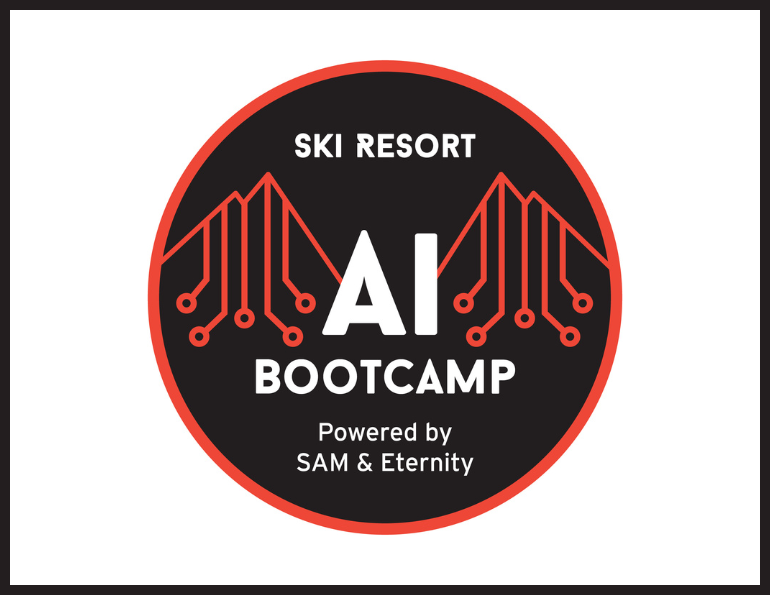At ski areas exploring the potential of artificial intelligence, early use cases are emerging not as sweeping overhauls, but as incremental innovations designed to improve safety, streamline work, and clarify planning.
In Québec, Les Sommets is using visual AI systems to monitor lifts. In New Hampshire, Cannon Mountain is analyzing historical data with AI to strengthen operational planning. And at New York’s Greek Peak, leadership is pushing vendors to think bigger about what AI can make possible in snowmaking, beyond traditional automation.
Smarter Chairlift Monitoring
Les Sommets, owner of five Quebec ski areas, was an early adopter of computer-vision technology in lift operations. For more than seven years, the company has utilized a Bluecime SIVAO “third-eye” system at Sommet Saint-Sauveur to monitor whether lift riders are lowering restraint bars. This winter, Saint-Sauveur’s flagship six-place chairlift will also utilize Mantis, a more advanced camera-and-AI platform that assists with identifying and preventing misloads.
Greg McCullough, vice president of operations at Saint-Sauveur, said discussions with friends who used AI-enabled cameras to ensure quality control in printing operations helped him see the potential for improving lift operations. “In a fraction of a second, [AI can identify] a misprint on a label … and pick it off the [production] line,” he said. “Now, we’re talking about [applying similar technology to] chairlifts that have six- or seven-second interval arrival times.”
With Bluecime, he said, “recognition is based on a photo of the [carrier] coming out of the terminal, and it triggers an alarm to tell the person that they must lower their bar.” The system also gathers performance data, such as real-time lift speeds, bar-down rates, and percentage of people on the chair.
“The feedback that the system gives you from an operational basis is really, really [valuable],” he said. “When we go into operation this year, we’ll have seven years of data already acquired by the system.”
The resort has also been collecting data for the Mantis system for the last three years as part of a pilot program. Mantis, which is now a development partner of Doppelmayr, is designed to integrate with lift control systems and handle more complex decision-making to enable fully automated lift operations. “In Europe now, there are many installations that are running autonomously through Mantis and other suppliers,” noted McCullough.
Regulations do not currently allow for fully automated lift operation in North America, but McCullough, who sits on the Quebec passenger ropeway committee for the CSA Z98 standard, believes the code and culture can evolve. “It’s a little bit of a gray zone that we’re working on right now. It’s, as we say, a work in progress.”
For now, Saint-Sauveur will use Mantis “as an assisted program, which will take the onus of operation off of the lift operator, but not 100 percent,” McCullough said. If the system detects a misload, it can automatically stop the lift, though a human operator is still required by regulation to be on site and handle restarts.
Even for the best lifties, bumping chairs for hours on end becomes monotonous, said McCullough. Technology like Bluecime and Mantis helps mitigate the risks that come with inevitable complacency. “If we can have a safer operation because the machine is not going to miss a fall if programmed properly, if it has enough information, then I have no qualms jumping on this 100 percent,” he said.
“I’ve been at it 40 years,” he added, “and I’m hoping that by the time I’m done, this will be a step that I’ve helped [us] move in the right direction.”
Strategic Snowmaking
Greek Peak in Cortland, N.Y., is exploring how AI could one day transform snowmaking operations, and vice president of operations Ayden Wilber is urging suppliers to expand their AI capabilities. While the resort uses automated fan guns today, Wilber is pushing for more sophisticated, decision-making tools that go beyond preprogrammed inputs.
“Say you have an automated snow gun, and you want [it] to turn on when it senses a certain pressure in the water line or at a certain temperature that it’s reading on a weather station. That is more than likely not AI,” he said. “What we’re looking for is for AI to be able to interpret data and make decisions that are above and beyond what’s programmed.”
“A perfect example is if there are a couple of cold nights where the guns all of a sudden decided to go to 160 gallons a minute and are using a little bit more water than we wanted because we’re trying to ration it around the mountain,” said Wilber, “someone needs to manually go and dial that back a little bit” in the automated system. In the future, he said, AI would be able to adjust the output without human assistance and prioritize the amount of water or compressed air going to certain trails or areas based on the resort’s early season needs.
From an efficiency and cost savings standpoint, the turning point will be “when we can start to get systems that aren’t typically connected starting to speak to each other and interpret and use data together,” said Wilber, such as integrated grooming snow-depth technology and snowmaking systems.
With integrated tools, resorts could better target high-traffic or erosion-prone terrain and avoid wasting resources elsewhere. “We can really hone our efficiency so we’re not making six feet of snow where we’re not going to need it in April,” said Wilbur.
AI might also help fill the void of institutional knowledge as experienced workers age out. “Instead of us using our tribal knowledge of the guys who have been working out on the hill for the last 20 or 30 years,” said Wilber, “this is where AI can step in and help. You become less human reliant, and it protects the ski resort going into the future.”
Wilber said that staff reaction to machine learning-led ops has been mixed, depending on their generation—many longtime snowmakers probably aren’t huge fans of automation. “But then some of the younger guys love it [because they] are looking for a more efficient way to do things instead of dragging hundreds of hoses out on the hill and having to go manually check every gun,” he said.
Forecasting for the Future
Cannon Mountain general manager Jace Wirth arrived in Franconia, N.H., from the West less than two years ago and immediately set out to understand the resort’s notoriously complex microclimate. “Snowmaking is one [challenge] that I wanted to get my arms around,” he said.
Fortunately, Cannon has a data-rich partnership with its neighbor the Mount Washington Observatory, which operates automated weather stations on Cannon Mountain as part of a regional mesonet. “We’ve got weather stations at high and low elevations and basically just a treasure trove of data going back to 2013,” said Wirth. “By treasure trove, I’m talking in five-minute increments basically everything that you’d want to know about the weather.”
To make sense of the massive dataset, Wirth used AI to accelerate the analysis. “It would probably take someone with a good grasp ... a week or two to do that,” he said. “I could do it in about 30 seconds” and at little cost using AI.
Using the weather station data, Cannon created a statistical analysis dashboard that integrates the resort’s snowmaking capacity to generate predictions on variables like per-acre application rate (i.e., gallons per acre-foot).
“We needed to clear up some confusion,” said Wirth. “Some [people] were basing productivity questions on their own independent weather forecasting.” Now, the dashboard uses historical data to guide decisions like route selection and opening day targets. “Our opening dates had varied widely within the last seven years,” said Wirth. “And I needed to find out, ‘OK, what can the business handle?’ but also, ‘what can the weather do for us?’”
Cannon traditionally has opened for the season on the day after Thanksgiving, but increasingly marginal temperatures in Franconia Notch have made that goal more elusive. “Using our dashboard,” said Wirth, “we felt very comfortable early on planting our flag and saying, ‘As long as this and this goes right, as long as we’re ready for it, we can hit that.’ Last November turned out to be one of the warmest that we’ve had since 2015, [but] we opened right on time. That helped reinforce with our team that the use of this information can justify solid decisions.”
AI won’t replace the deep knowledge or instincts of experienced operators, but as these early examples show, it’s already helping resorts work smarter, plan better, and prepare for what’s next.
AI Tools for Today
Mike Lannen, founder of digital agency Eternity and co-host of the Ski Resort AI Bootcamp, shared two practical AI applications resort operations teams may want to consider:
- Live translation with ChatGPT: Ops team members working alongside international staff can translate conversations in real time using the free version of ChatGPT’s mobile app, easing language barriers in training and team building. “You can use it verbally—and not just Spanish, every single language,” said Lannen.
- Custom GPTs for maintenance support: A custom GPT trained on lift manuals and incident reports could help staff troubleshoot technical issues, said Lannen. With a properly trained GPT, he said, “You could simply hop into the GPT and say, ‘Hey, I’m getting an emergency brake bypass fault and I can’t reset it—what should I do?’”
“These tools don’t replace humans,” said Lannen, “but they can help you get to a little bit of information faster.”
This article is based on the July 22, 2025, Ski Resort AI Bootcamp session “Modern Tools for Mountain Ops,” powered by SAM and Eternity. Learn more at saminfo.com/ai-bootcamp.






